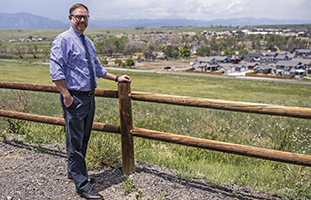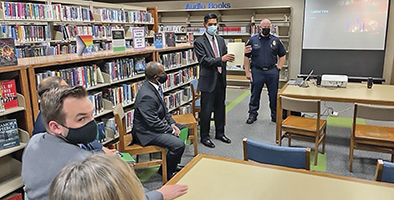Steering Through Disasters and Tragedy
August 01, 2022
In the past two years, these three superintendents have faced devastating natural crises in their school communities on top of a pandemic

On the morning of Aug. 27, 2020, Karl Bruchhaus, superintendent of Calcasieu Parish school system, weaved 50 miles through hurricane debris to his district’s technology center in Lake Charles, La. Power and cellphones were dead. But the center had
emergency generator service, access to e-mail, the internet and computer files and maybe some members of his administrative crisis team.
During 26 years in the district, his last eight as superintendent, Bruchhaus usually rode out Gulf
Coast hurricanes. But this time he sheltered with relatives as his staff, 33,000 students and most parish residents also evacuated. Hurricane Laura had become a massive Category 4 storm with sustained winds of 150 miles per hour, one of the three
largest ever to hit Louisiana.
Like Bruchhaus, Skylar Dever Fontenot, the Calcasieu Parish’s risk manager, drove her jeep the next morning to the tech center, past destroyed homes, a roofless LaGrange High School and the Fox News
transmission tower that had tumbled onto the Golden Corral restaurant.
Lake Charles, she says, “looked like a war-wrecked city.”
By afternoon, Bruchhaus, Fontenot and three other administrators were in the tech center,
communicating with scattered staff, students and families through e-mail. They also sent two remediation companies to assess damage and begin repairing schools.
The hurricane was the first of four extreme weather-related events to strike
Calcasieu Parish in 2020-21. It was followed by a second hurricane, a February deep freeze and major flooding in May. The series of disasters cost 70 instructional days and displaced thousands of students, 4,000 of whom have left the school district.
This Content is Exclusive to Members
AASA Member? Login to Access the Full Resource
Not a Member? Join Now | Learn More About Membership
Author
Voices of Experience: Preparing a District for Disaster
Every natural disaster arrives with surprises, but there’s plenty school system leaders can do to prepare, according to those who’ve led their districts through floods, fires and storms in the recent past.
Education leaders must
move fast on multiple fronts after disaster strikes, they say, so it helps to already have established a crisis management team and strong connections with other government and agency leaders. Crisis teams typically include a superintendent’s
cabinet members, risk managers, financial officers, counselors and school board members.
Superintendents put these leaders in charge of critical functions such as coordinating with the Federal Emergency Management Agency, securing emergency
loans, coordinating do-nations, setting up trauma support teams, assessing property damage, launching repairs and communicating with students, parents and staff.
A Coordinated Response
The Boulder Valley, Colo., School District’s early preparations helped it quickly coordinate its response to the destructive Marshall Fire last December, superintendent Rob Anderson says. The district previously had met with city and government
leaders for tabletop exercises about responding to a crisis. He says his crisis team established an effective chain of command.
“You can’t have everybody in charge of everything,” Anderson says. “You have to quickly
coordinate and assign a chain of command and then let those folks lead.”
Within hours after the fire erupted, Tammy Lawrence, Boulder Valley’s director of student support services, was meeting with her trauma teams. And Rob
Price, assistant superintendent of operational services, was watching the fire’s progress on his home computer through school security cameras. He was able remotely to close the dampers in schools to keep out smoke.
“Every school
district needs an outreach coordinator,” says Annette Lane, superintendent of Pioneer Union School District in northern California. She hired someone to organize and distribute the flurry of donations and relief supplies that rolled in after
a wildfire burned 400 homes and one school in her district last August. Also, Lane says, her district had established an evacuation plan before the fire that helped people in her district flee the wildfire. It appears now on the home page of the Pioneer
website.
Suggestion List
School administrators have learned other practical measures in natural disaster preparation. After enduring two hurricanes, a freeze and flood in Louisiana’s Calcasieu Parish school system last year, Skylar Dever Fontenot, the district’s risk manager, and Wilfred Bourne, chief financial officer, developed these suggestions for school administrators:
- Put a system in place to remotely manage central-office processes such as payroll.
- Have a backup generator at your main office, a backup computer server and hard copies for critical district information, such as buildings’ floor plans and heating and ventilation systems.
- Build up cash reserves.
- Make sure you have adequate insurance and follow the company’s rules to avoid jeopardizing insurance claims.
- Set up a process for documenting damage and for recovering expenses, including funds for overtime for staff.
- Have prepositioned contracts in place for a project manager, remediation company and grant consultant familiar with FEMA.
- Move buses to high or safe ground and have staff clean out refrigerators before the disaster approaches.
- Make a master key to give remediation and other emergency workers access to all schools.
Many superintendents admit they did not study how to prepare for calamities in their academic credentialing programs. It may be time, some say, for universities to offer a course about leading through natural disasters.
In Disaster’s Aftermath: Stemming the Erosion of Instructional Time

In spring 2019, Ed Manansala, El Dorado County superintendent of schools in California, assembled leaders of the county’s 15 school districts for a retreat to establish what he called a “relentless focus on instruction and learning.”
Less than a year later, COVID-19 arrived, forcing the county’s 30,000 students to learn virtually from home. Then, in mid-August 2021, just as the schools were preparing to bring students back into classrooms, the Caldor Fire erupted.
The blaze quickly forced the evacuation of thousands of residents in the rural county, which spreads over 180,000 square miles between Sacramento and Lake Tahoe in some of Northern California’s 1849 Gold Rush country. The fire closed
six school districts and burned 1,003 structures and 222,000 acres over two months.
“Our world turned upside down,” Manansala says.
Educators who still had homes scrambled to teach. Some teachers set up class in a
public library. Others provided virtual lessons. Still, the fire disrupted instruction for weeks.
After the fire burned the small Walt Tyler Elementary School and 400 homes in El Dorado County’s Grizzly Flats, the 300-student Pioneer
Union School District closed for three weeks. Once open, says superintendent/principal Annette Lane, the district placed 30 of the 34 Walt Tyler students in its Somerset Elementary School and offered virtual instruction and independent study for students
in temporary housing elsewhere.
Forced Absences
Scientists say climate change is helping fuel a rise in the number and strength of natural disasters across the country. And that’s costing instructional time even as the COVID-19 pandemic has spurred widespread absences and learning loss. For example,
the 33,000 students in Louisiana’s Calcasieu Parish school system last school year lost 70 instructional days after two hurricanes, a deep freeze and floods repeatedly shut down the schools.
Wildfires have grown in size and intensity
and become a big source of lost instructional time, especially in the West and Southwest. Acreage burned by wildfires each year has in-creased since the 1980s, with the 10 years of the largest burns occurring since 2004.
California sees
about 7,000 to 8,000 fires a year. Superintendents now need to be prepared not only for snow days, but for a pandemic, wildfire, air quality degraded by smoke, even planned power shutoffs by utility companies as part of wildfire prevention, Manansala
says.
That all adds up to lost instructional days.
Sharp Losses
CalMatters, a nonprofit news site, used California Department of Education data to report that between 2002 and 2019, public schools lost 21,442 days to wildfires, with a disaster day equaling a lost day of instruction at a single public school. Those
losses occurred in 6,542 schools, affecting more than 3 million students, and about half were in the last two years.
Educators nationally need to find ways to sustain quality instruction even when hit by fires, hurricanes, tornadoes and
floods, Manansala says.
“We have to manage through,” he says. “From the Caldor Fire to snow days, how do we develop systems that provide consistency of instruction and learning, even in the midst of those?”
Advertisement
Advertisement
Advertisement
Advertisement



